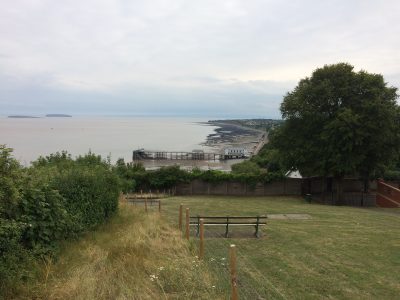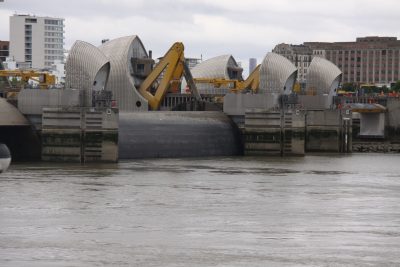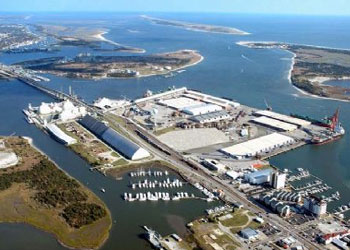
Editor’s Note: The story was updated 4 p.m. Thursday, Nov. 30.
For some people who become deeply enmeshed in climate change and its impacts, there’s one event, maybe one scientific finding that figuratively smacked them in the face and set them on that path. It could have been Al Gore’s 2006 movie, “An Inconvenient Truth,” or a summer of soaring temperatures, or a government report.
Supporter Spotlight
Rachel Willis, a University of North Carolina Chapel Hill professor who’s becoming well known for advocating that the world’s transportation infrastructure must increasingly work with – not against – climate change and sea level rise, didn’t get figuratively smacked. She literally got socked.
Willis, who teaches in the Department of American Studies at UNC, is by training a labor economist, and back in the 1990s, she’d been working on research about child care facilities and the benefits to the economy, work that helped lead to the legislation that created North Carolina’s Smart Start program for preschoolers.
In 1994 at a conference, she met a sock manufacturer. He introduced her to an industry specialist who created training programs to help factory owners and managers communicate more effectively with employees and help workers. In a labor economist professor’s mind, something clicked. But it wasn’t climate change. It was simply that socks were manufactured and transported all over the world: a great case study.
So for a decade, Willis went all over the world – Italy, China, the Czech Republic, and of course, all around North Carolina – to learn about socks: how they’re made, who makes the equipment that makes them, how they’re sold, how they’re marketed. She interviewed thousands of people, she said in a recent interview with Coastal Review Online.
And in the process, something clicked again: It wasn’t really about the socks. It was about the future of manufacturing. It was about competitiveness, it was about transportation. And ultimately, it became about climate change, because Willis realized that as the world’s atmosphere and oceans warm and expand and sea level rises, transportation infrastructure – roads and bridges and ports – are increasingly threatened. Coastal infrastructure is also threatened by increasingly frequent and more powerful storms.
Supporter Spotlight
“It all just sort of came together,” she said. “I’d always believed in climate change, but I really didn’t know much about it.” For someone who spent 10 years learning about the global sock trade, she dove in with enthusiasm, and came to believe that climate change and all of its ramifications – sea level rise, droughts, increasingly frequent and more powerful hurricanes and other storms – threatens the world’s economy, and by extension, its people. Not later. Now.
So she started traveling again, but this time with a new purpose, to learn about how other countries are dealing with infrastructure, ports and bridges and roads, especially, at edge of the waters, where sea level rise is naturally going to have the most impact.

She went to the Netherlands because that country has come to learn to work with nature after years of trying to conquer it. She went to the Welsh city of Cardiff on Cardiff Bay, which she said had, until about two decades ago, among the biggest daily tidal shifts of any water body in the world, so dramatic that access to the sea was limited to a couple of hours each side of high water.
She went to London, which is bisected by the Thames River, that throughout history has been responsible for devastating floods in parts of one of the world’s great cities.
What she saw in all of those places were changes, innovations, the results of the kind of thinking she believes has come to be in short supply in the United States, at least on these kinds of issues.
In the Netherlands, where about 20 percent of the land is below sea level, she saw the biggest flood barrier in the world. Called Maeslantkering, a part of the Delta Works project that began in the 1980s, it’s controlled by a supercomputer and closes if the city of Rotterdam is threatened by storm surge.
To get there, Willis first rode on an electric train that ran on power generated from wind energy, then rented a bike, something she said is a ubiquitous practice in the country.
Things clicked again.
Millions of Dutch workers commute daily by bicycle. All of the country’s electric trains run on wind energy. That’s a considerable difference from the U.S., where the interstate highway system is the hub of transportation, and almost no one bikes to work, comparatively speaking.
“It was pretty amazing to see,” Willis said. “They learned a long time ago to use what they have, and to take problems – like high wind – and turn them into solutions.”
They’ve built ports and shipping facilities that are generally safer from the impacts of sea level rise because of the Maeslantkering and Delta Works. The Dutch, she said, take water management as seriously as the U.S. takes national defense, because, in a real sense, it is national defense for such a low-lying country.
The Dutch, she said, also have turned the whole Maeslantkering, in what is known as the Hook of Holland, into an attraction, an economic engine.
There’s a museum there, for example, that educates people about the impacts of storm surge, the water that floods areas as storms roar ashore.
In the United States, Willis said, we warn people about storm surge during hurricanes, but after the storm surges occur and areas flood, the news media report the devastation and then “everybody moves on and it’s forgotten in a couple of weeks.” And nothing much changes.

In London, Willis saw the Thames Barrier, a series of 10 steel gates that are level with the river bottom until flooding threatens London. They are raised when the threat occurs – to what she said is the height of a five-story building – and block the rising waters. It holds the waters, then lets them out, slowly, after the event, a process that’s coordinated so canals along the river don’t flood.
In Cardiff, Willis said, she saw the system called Barrage, which was built and completed with European Union money about 20 years ago. What it does, she said, is retain water in the bay, essentially creating a more permanent bay and keeping the dramatic tidal shift from exposing a vast muddy bottom that was unattractive. And again, the area has become an economic engine, she said, as there are numerous shops and attractions, as well as pedestrian and bike paths.
It’s this kind of innovative thinking, Willis said, that gives her hope for efforts in the U.S. in general, and North Carolina in particular, to protect flood-prone areas.
“I’m not pessimistic, I’m optimistic,” she said. “But people in North Carolina and elsewhere need to vote for people who understand the science of climate change and what is at stake. Then we all have to plan and act cooperatively to work for future generations to be able to enjoy the North Carolina coast. We can do this, but we have to be realistic.”
She said that in Denmark, which she’s also visited, ferries are major carriers of not only people, but also cargo, serving as links between railroads. The same, she said, is true in Ireland. In some places, multi-level “super” ferries, some six or seven stories tall, carry buses, cars, bicyclists, pedestrians and cargo.
Willis can envision that type of thing in North Carolina, in conjunction with other changes in the transportation system.
Ferries, she said, could move people to the Outer Banks, and light rail systems along the banks and golf carts could carry them to where they need to go once they are there. The whole idea, she said, is that roads are so expensive to maintain, especially in the wake of sea level rise, and these other transportation methods are less expensive to maintain and less expensive to replace than flooded and destroyed roads.
These alternative transportation methods would also be far less damaging to the environment, she said, and would reduce the carbon output that contributes to climate change. So would more bike paths and pedestrian walkways.
In keeping with her training as a labor economist, Willis would like to see the state, the nation and world embrace different methods of getting things from “here to there.”
The U.S., she said, has for too long relied too heavily upon air planes and overland transportation of goods, largely by trucks, when rail and water transportation are far less costly these days for companies.
It costs about 80 cents per mile to move one metric ton of freight on an airplane, she said in the interview. It costs 27 cents to move it by truck. It costs two cents by rail and only one cent by water.
“That – the water transportation cost – is amazing,” she said. “It’s 1/27th of the cost by truck.” And it dramatically reduces the carbon input into the atmosphere, especially if cargo vessels and trains can over time be switched to alternative sources.
Morehead City, she said, is in good position to benefit from these concepts, since the state port is served by a railroad, thanks to the vision of the city’s namesake Gov. John Motley Morehead, who got the track built way back in the 1800s.
It was, Davis said, an idea that made sense then, fell out of favor as interstate highways took over as routes for commerce, but makes even more sense now.
Willis is in line with Orrin Pilkey, a Duke University professor and researcher who for decades has preached the need for a strategic retreat of structures from the oceanfront.
“The major storms and flooding events are happening more frequently,” she said. “Does that mean we have to abandon the Outer Banks? No, of course not. But we have to have a better plan. We have to have policies and incentives to that discourage building at the water’s edge.
“What we do now is encourage it by subsidizing risk,” Willis continued, through government-subsidized flood and wind insurance, for example, and by allowing destroyed buildings to be rebuilt exactly where they were, in most cases.
Like Pilkey, she said a good first step would be to simply not allow that to happen. There should also be government-sponsored buyouts for the people who own those structures.
“What we do now is just irrational,” she said. “There have been plenty of cues in recent years that we need to change our thinking. We’ve had some very big cues just the last couple of months: Hurricane Harvey in Houston, Irma in Florida and Maria in Puerto Rico. And it’s not just in the United States.”
It’s clear, Willis said, that in some instances, wealthy countries and communities can reduce the risks of sea level rise and storm surge damage with engineering marvels that cost billions. But it’s also clear that not all countries, or even all communities in rich countries, have the resources to do that.
“We’re going to have to make hard choices, determine what is most important for us to protect, what is the most important in terms of the number of people and the economy.”
Ports are, and should be, high on the list of top choices for protection, she added, and not just American ports.
“Who are we shipping to?” she asked. “And who is shipping to us, and what are we shipping? Do we want bananas, for example? Do we want concrete and steel and the raw materials we need for products we make?

“It’s a global problem, and we can’t afford to just think about our infrastructure, our ports. We need to care about other places. We’re all in this together. We need be holistic in our approach.”
Willis said that means policymakers and others who are concerned should go to other countries, as she has done, to learn more about how they are adapting to rising sea levels.
“You can’t legislate sea level to stop rising,” she said. “This is not a problem that’s going away. It’s water over the bridge, and it’s going to happen more often and with greater severity in coming years.”
Planners must also think holistically about individual projects: How will it affect its entire region?
“If you build something to protect Manhattan, that water will go somewhere else,” she said. “The Thames Barrier is an integrated system that works with 18 or so other canals. These are complex problems with complex solutions.”
And, Willis said, stakeholders – fishermen, residents, business owners – must have input into the processes that lead to innovative solutions.
“You want protection when it’s needed, but you also want to maintain fishing and aquaculture and the other things that contribute to the economies,” she said.







